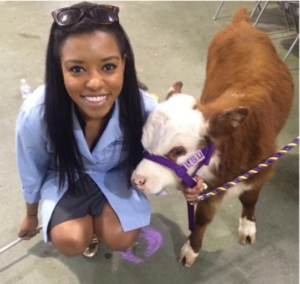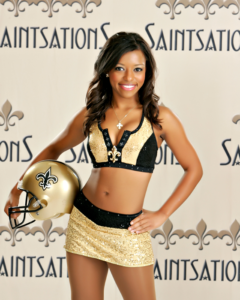Hi Science Cheerleader fans, Melissa here! We love animals and so does our newest Science Cheerleader, Derecka! She’s a Veterinary Medicine student and NFL Cheerleader.
What turned you on to STEM and when?
 The world around me has always intrigued me and ever since I was a little girl, I knew I wanted to work with animals. I was in middle school when I decided to take my aspiration for being an animal doctor to the next level by being a volunteer for the Audubon Aquarium in New Orleans. I enjoyed talking to the public about the animals in the exhibits at the aquarium and wanted to learn more about how to properly care for the creatures that can’t communicate to people what’s wrong.
The world around me has always intrigued me and ever since I was a little girl, I knew I wanted to work with animals. I was in middle school when I decided to take my aspiration for being an animal doctor to the next level by being a volunteer for the Audubon Aquarium in New Orleans. I enjoyed talking to the public about the animals in the exhibits at the aquarium and wanted to learn more about how to properly care for the creatures that can’t communicate to people what’s wrong.
So what exactly do you do?
Currently, I am a third-year veterinary student at Louisiana State University School of Veterinary Medicine. Majority of my time is spent in class, lab, and at the library studying what I learned that day. I am taking a lot of classes and learning the information I’ll need to know for when I enter my rotations in the clinics.
What does it mean for you to work in veterinary medicine?
About 75% of emerging infectious diseases are zoonotic. Zoonotic diseases are diseases animals can get and give to humans or humans get and give to animals. I believe the health and lives of the general public depend on smart veterinarians who can pick up on an outbreak and control the spread of infection. In the role of a Public Health Veterinarian, I can contribute to controlling diseases and outbreaks using my skills to heal sick animals and doing so will directly save millions more (people included). I would also like to step outside the norms by providing my expertise to the international community, which is increasingly being challenged by our ever-growing global interconnections.
 You’re a cheerleader for the NFL’s New Orleans Saints! How do the qualities that make you a great cheerleader benefit you in your STEM career?
You’re a cheerleader for the NFL’s New Orleans Saints! How do the qualities that make you a great cheerleader benefit you in your STEM career?
Two major qualities cheerleaders have in common are having great communication skills and great athletic abilities. As a veterinarian student, I’ve been challenged in the area of having to work on creatures that are ten times smaller than me to ten times my size. When it comes to examining a strong horse, keeping my core tight and balancing on my tippy toes goes a long way. The communication skills come in handy when I have to communicate to owners what is going on with their animal. If I can clearly communicate with the client, I know I’ll have a better chance of understanding the animal’s problem and coming up with a solution.
How do you feel about breaking down negative stereotypes about cheerleaders and women in science?
I love the purpose of Science Cheerleaders. Throughout my life I encountered people who tried to make me choose between dancing/cheering and challenging myself in the classroom. It is important for the public, especially young boys and girls to see examples of people who do what they love, while excelling inside and outside the classroom. Having different experiences catering to my STEM career definitely helped me be a better cheerleader and, in return, my cheerleader experiences helped cultivate me into a better candidate for a STEM profession.
Best cheerleading experience?
My most memorable cheerleading experience was at the National Kidney Walk in New Orleans. It was a very gloomy, muggy Louisiana morning. My teammate and I arrived at the event to find out that the DJ scheduled was a no-show and that there would be no sound system or warm-up music for participants. I asked my teammate to contact her brother (an aspiring DJ) because he had just dropped us off and still had his DJ equipment in the car from a gig the night before. In a matter of minutes, two cheerleaders turned a low-spirited start to a phenomenal blast! We were able to get the crowd grooving to some great warm-up tunes and kept the good vibes flowing after the walk. This was the best event I attended because I was able to show the public how a Saintsation is not only important to cheering on a NFL team when the times get rough, but is also important to lifting up those in the New Orleans Saints’ community. Whether it be bouncing back during flood recovery or inspiring those battling chronic illnesses, cheering and championing people to feel the best while doing the best is very important. I also enjoyed racing the kids in the bounce house; they didn’t think this cheerleader had it in her!
Best STEM-related experience?
My best STEM-related experience was when I got to travel one summer to Araçatuba, São Paulo, Brazil, to perform public health research on Leishmaniasis. This zoonotic parasite is usually picked up by dogs and sometimes passed on to humans. Understanding the cycle of this disease can be pretty challenging, and since Portuguese is not my first language, I had to put extra effort in keeping up with the lab protocols. Fortunately, I had a great mentor who, along with her amazing staff, helped me get acclimated to the different laboratory environment. It was great experiencing how people in a different country speaking a different language use science to connect to the rest of the world in hopes of helping animals and humans alike.
What advice would you give your 12-year-old self?
The advice I would give my 12-year-old self would be to not let people around you discourage you from achieving what you perceive as greatness. Not everyone will understand why you want to take the path you’re taking. Don’t worry about sticking to a left brain or right brain way of thinking. As long as you stay true to your heart, you’ll be guided in the right direction.

